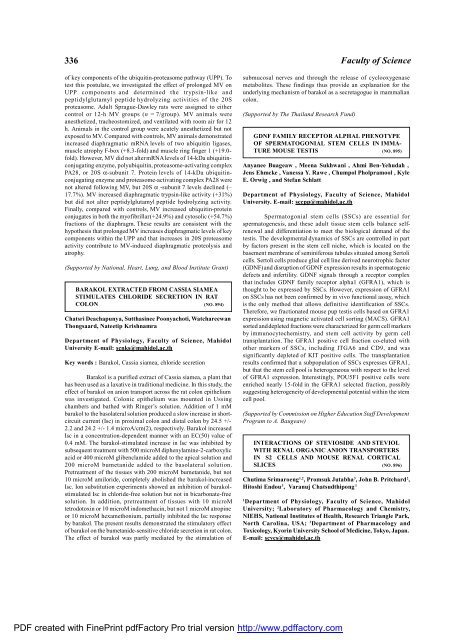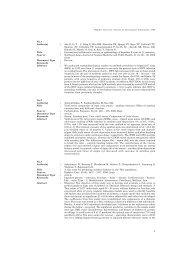Faculty of Science - Mahidol University
Faculty of Science - Mahidol University
Faculty of Science - Mahidol University
You also want an ePaper? Increase the reach of your titles
YUMPU automatically turns print PDFs into web optimized ePapers that Google loves.
336<br />
<strong>of</strong> key components <strong>of</strong> the ubiquitin-proteasome pathway (UPP). To<br />
test this postulate, we investigated the effect <strong>of</strong> prolonged MV on<br />
UPP components and determined the trypsin-like and<br />
peptidylglutamyl peptide hydrolyzing activities <strong>of</strong> the 20S<br />
proteasome. Adult Sprague-Dawley rats were assigned to either<br />
control or 12-h MV groups (n = 7/group). MV animals were<br />
anesthetized, tracheostomized, and ventilated with room air for 12<br />
h. Animals in the control group were acutely anesthetized but not<br />
exposed to MV. Compared with controls, MV animals demonstrated<br />
increased diaphragmatic mRNA levels <strong>of</strong> two ubiquitin ligases,<br />
muscle atrophy F-box (+8.3-fold) and muscle ring finger 1 (+19.0fold).<br />
However, MV did not alter mRNA levels <strong>of</strong> 14-kDa ubiquitinconjugating<br />
enzyme, polyubiquitin, proteasome-activating complex<br />
PA28, or 20S α-subunit 7. Protein levels <strong>of</strong> 14-kDa ubiquitinconjugating<br />
enzyme and proteasome-activating complex PA28 were<br />
not altered following MV, but 20S α -subunit 7 levels declined (–<br />
17.7%). MV increased diaphragmatic trypsin-like activity (+31%)<br />
but did not alter peptidylglutamyl peptide hydrolyzing activity.<br />
Finally, compared with controls, MV increased ubiquitin-protein<br />
conjugates in both the my<strong>of</strong>ibrillar (+24.9%) and cytosolic (+54.7%)<br />
fractions <strong>of</strong> the diaphragm. These results are consistent with the<br />
hypothesis that prolonged MV increases diaphragmatic levels <strong>of</strong> key<br />
components within the UPP and that increases in 20S proteasome<br />
activity contribute to MV-induced diaphragmatic proteolysis and<br />
atrophy.<br />
(Supported by National, Heart, Lung, and Blood Institute Grant)<br />
BARAKOL EXTRACTED FROM CASSIA SIAMEA<br />
STIMULATES CHLORIDE SECRETION IN RAT<br />
COLON (NO. 894)<br />
Chatsri Deachapunya, Sutthasinee Poonyachoti, Watchareewan<br />
Thongsaard, Nateetip Krishnamra<br />
Department <strong>of</strong> Physiology, <strong>Faculty</strong> <strong>of</strong> <strong>Science</strong>, <strong>Mahidol</strong><br />
<strong>University</strong> E-mail: scnks@mahidol.ac.th<br />
Key words : Barakol, Cassia siamea, chloride secretion<br />
Barakol is a purified extract <strong>of</strong> Cassia siamea, a plant that<br />
has been used as a laxative in traditional medicine. In this study, the<br />
effect <strong>of</strong> barakol on anion transport across the rat colon epithelium<br />
was investigated. Colonic epithelium was mounted in Ussing<br />
chambers and bathed with Ringer’s solution. Addition <strong>of</strong> 1 mM<br />
barakol to the basolateral solution produced a slow increase in shortcircuit<br />
current (Isc) in proximal colon and distal colon by 24.5 +/-<br />
2.2 and 24.2 +/- 1.4 microA/cm(2), respectively. Barakol increased<br />
Isc in a concentration-dependent manner with an EC(50) value <strong>of</strong><br />
0.4 mM. The barakol-stimulated increase in Isc was inhibited by<br />
subsequent treatment with 500 microM diphenylamine-2-carboxylic<br />
acid or 400 microM glibenclamide added to the apical solution and<br />
200 microM bumetanide added to the basolateral solution.<br />
Pretreatment <strong>of</strong> the tissues with 200 microM bumetanide, but not<br />
10 microM amiloride, completely abolished the barakol-increased<br />
Isc. Ion substitution experiments showed an inhibition <strong>of</strong> barakolstimulated<br />
Isc in chloride-free solution but not in bicarbonate-free<br />
solution. In addition, pretreatment <strong>of</strong> tissues with 10 microM<br />
tetrodotoxin or 10 microM indomethacin, but not 1 microM atropine<br />
or 10 microM hexamethonium, partially inhibited the Isc response<br />
by barakol. The present results demonstrated the stimulatory effect<br />
<strong>of</strong> barakol on the bumetanide-sensitive chloride secretion in rat colon.<br />
The effect <strong>of</strong> barakol was partly mediated by the stimulation <strong>of</strong><br />
submucosal nerves and through the release <strong>of</strong> cyclooxygenase<br />
metabolites. These findings thus provide an explanation for the<br />
underlying mechanism <strong>of</strong> barakol as a secretagogue in mammalian<br />
colon.<br />
(Supported by The Thailand Research Fund)<br />
<strong>Faculty</strong> <strong>of</strong> <strong>Science</strong><br />
GDNF FAMILY RECEPTOR ALPHAL PHENOTYPE<br />
OF SPERMATOGONIAL STEM CELLS IN IMMA-<br />
TURE MOUSE TESTIS (NO. 895)<br />
Anyanee Buageaw , Meena Sukhwani , Ahmi Ben-Yehudah ,<br />
Jens Ehmcke , Vanessa Y. Rawe , Chumpol Pholpramool , Kyle<br />
E. Orwig , and Stefan Schlatt<br />
Department <strong>of</strong> Physiology, <strong>Faculty</strong> <strong>of</strong> <strong>Science</strong>, <strong>Mahidol</strong><br />
<strong>University</strong>. E-mail: sccpp@mahidol.ac.th<br />
Spermatogonial stem cells (SSCs) are essential for<br />
spermatogenesis, and these adult tissue stem cells balance selfrenewal<br />
and differentiation to meet the biological demand <strong>of</strong> the<br />
testis. The developmental dynamics <strong>of</strong> SSCs are controlled in part<br />
by factors present in the stem cell niche, which is located on the<br />
basement membrane <strong>of</strong> seminiferous tubules situated among Sertoli<br />
cells. Sertoli cells produce glial cell line derived neurotrophic factor<br />
(GDNF) and disruption <strong>of</strong> GDNF expression results in spermatogenic<br />
defects and infertility. GDNF signals through a receptor complex<br />
that includes GDNF family receptor alpha1 (GFRA1), which is<br />
thought to be expressed by SSCs. However, expression <strong>of</strong> GFRA1<br />
on SSCs has not been confirmed by in vivo functional assay, which<br />
is the only method that allows definitive identification <strong>of</strong> SSCs.<br />
Therefore, we fractionated mouse pup testis cells based on GFRA1<br />
expression using magnetic activated cell sorting (MACS). GFRA1<br />
sorted and depleted fractions were characterized for germ cell markers<br />
by immunocytochemistry, and stem cell activity by germ cell<br />
transplantation. The GFRA1 positive cell fraction co-eluted with<br />
other markers <strong>of</strong> SSCs, including ITGA6 and CD9, and was<br />
significantly depleted <strong>of</strong> KIT positive cells. The transplantation<br />
results confirmed that a subpopulation <strong>of</strong> SSCs expresses GFRA1,<br />
but that the stem cell pool is heterogeneous with respect to the level<br />
<strong>of</strong> GFRA1 expression. Interestingly, POU5F1 positive cells were<br />
enriched nearly 15-fold in the GFRA1 selected fraction, possibly<br />
suggesting heterogeneity <strong>of</strong> developmental potential within the stem<br />
cell pool.<br />
(Supported by Commission on Higher Education Staff Development<br />
Program to A. Baugeaw)<br />
INTERACTIONS OF STEVIOSIDE AND STEVIOL<br />
WITH RENAL ORGANIC ANION TRANSPORTERS<br />
IN S2 CELLS AND MOUSE RENAL CORTICAL<br />
SLICES (NO. 896)<br />
Chutima Srimaroeng 1,2 , Promsuk Jutabha 3 , John B. Pritchard 2 ,<br />
Hitoshi Endou 3 , Varanuj Chatsudthipong 1<br />
1 Department <strong>of</strong> Physiology, <strong>Faculty</strong> <strong>of</strong> <strong>Science</strong>, <strong>Mahidol</strong><br />
<strong>University</strong>; 2 Laboratory <strong>of</strong> Pharmacology and Chemistry,<br />
NIEHS, National Institutes <strong>of</strong> Health, Research Triangle Park,<br />
North Carolina, USA; 3 Department <strong>of</strong> Pharmacology and<br />
Toxicology, Kyorin <strong>University</strong> School <strong>of</strong> Medicine, Tokyo, Japan.<br />
E-mail: scvcs@mahidol.ac.th<br />
PDF created with FinePrint pdfFactory Pro trial version http://www.pdffactory.com
















